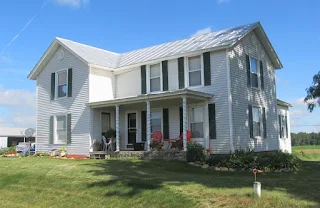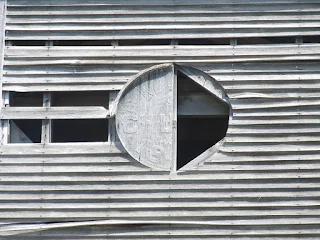 |
| You can click on the picture to embiggen and then just click on the picture to bring up the next. Some readers just want to look at the pictures. |
Today's leg was my longest leg at 18.2 miles by the truck odometer.
Yeah, I know. You used to walk 20 mile, double-time, 80 pound ruck hikes before breakfast back when you were in Cub Scouts. But that was back when you were young.
Architecture
Buildings are an economic response to climactic stresses. Those responses aret influenced by culture. The reason they are an 'economic response' is because the builder must comprehend the relative scarcity of various inputs.
One of the things I have been pondering as I walk in the heat are the features in the common farmhouse as seen in south-central Michigan. A few pictures follow.
 |
| This is the west side of a typical, Michigan farmhouse. Notice all of the windows to pick up prevailing breezes and that the second story windows are high, that is, shaded by the roof overhang until late in the afternoon. |
 |
| 12-12 roofs were the most common. |
 |
| Photo taken of the southeast aspect. Notice the trace of the chimney that ran up the east face (right side of photo) of the exterior wall. Chimneys on the east end of the house were less likely to spill embers onto roofs or into eaves. |
The resource constraints included labor, freight, length of boards, pre-electrification (i.e., no air conditioning).
The freight constraint meant that many of them had field stone foundations held together with the very minimum amount of cement. The foundation was prevented from buckling by backfilling the inside of the wall with fill.
Maximum common board length was 16'. In those days before trusses, that mean the maximum width of a room was restricted to 16' and more commonly, 12'.
Window were framed into 24" stud spacing. No cutting or fitting. Just pick a gap and nail in some horizontals.
 |
| Wind velocity increases rapidly as you go up in elevation. The effect is most pronounced where there is less ground clutter...like a house in the middle of a field. |
 |
| And peak air temperatures are lower, especially on calmer days when there is less mixing. Slide from HERE |
Houses were invariably two stories tall and sited on elevation.
"But ERJ, won't that make the house colder in the winter?"
A little bit...but they close the windows in the winter and did not make any attempt to heat the upper story. Remember, the upper floor had no plumbing fixtures to freeze.
Roofs were invariably "tin". That is, steel. They were shiny-galvanized to reflect heat. Later, they were painted with aluminum (pigmented) paint.
They all had porches. I was a bit surprised to noticed that there was no preferred orientation for the porch except...facing the road.
Now, onto the pictures without the lecture
 |
| It is a testament to how peppy I felt that I picked up this hook and carried it for 17 miles. |
 |
| A livestock farm northwest of Hastings, Michigan. |
 |
| Dew on a fence. Of course, you can never capture the dynamic of the different colors winking at you as you walk by. A few of the drops on the bottom give a hint. |
 |
| Very tough to call when they don't leave a phone number. Unless it is a VERY small town. |
This perennial weed has me mystified
 |
| Honeybees were all over this plant. It is about 2' tall and seems to favor spots with sharp drainage. That is, gravel and sand. |
 |
| Blue anthers, lavender filaments. |
 |
| Flower buds loaded in like rounds in a double-stack magazine. Any information regarding the identity of this plant will be appreciated. |
 |
| Butler Creek running through Hastings, Michigan. In the days before AC you would have seen a half-dozen bicycles parked here on a 90 degree day. |
 |
| A home orchard with a lot of potential. |
 |
| The trees are really struggling to compete with the sod. The sod gobbles up the nutrients, primarily nitrogen, and the tree is just hanging on. Being browsed by deer does not help matters. Dr ERJ recommends spraying herbicide (glyphosate works) to kill all grass within 4' of the trunk (8' diameter for the geometry impaired). That give it a whacking big dose of urea or mulch with 8" of leaves or hay. |
 |
| What is an Ohio Buckeye doing in Michigan? |
 |
| It was in the same yard as a few other interesting specimens. |
 |
| I think that house used to be owned by a "tree guy". These mulberries are large by local standards and slightly better tasting. You can see the sweat glistening from my hands. Picture taken about 11:00 AM local time. |
 |
| See why they call it "velvet". |
 |
| Staghorn Sumac. This one is odd because it is still carrying last years fruit pod. Ground sumac seeds are a staple in middle-Eastern cuisine. I wonder if Staghorn Sumac seeds taste the same. |
 |
| Sweet cherries have successfully "naturalized" in Michigan. That is, they grow wild. Cherry logs were historically used for fake cannon as the bark resembles the patina on a cast iron gun barrel. |
 |
| Breeders have a term "reversion to the mean" that means that any species will drift back to the wild form when selection pressure is removed. This is probably the gravest weakness of the "Noble Savage" theory of raising children. A child without guidance is no more noble than a chimp. |
 |
| This one is particularly photogenic because the cherries show up. |
 |
| Ditches filled with daylilies and sweet peas. It is a mighty pretty time of year to take a walk in the country. |
 |
| Sherman was a very common first name in 1900, at least in the North. |
 |
| Dualing churches. Both towers still had their bells. |
 |
| A Kentucky Coffeetree with a 48" trunk, well short of the National Champion's 65" diameter. Marked from removal because it is too close to the road. |
 |
| This is where my second water drop was located. |
 |
| The last third of the walk was notable for ponds. |
 |
| And ripe berries. |
 |
| This area is probably a bird-watchers paradise. |
 |
| Emerald Ash Borer hammered this portion of the Mud Creek floodplain. |
 |
| A look up the creek. |
 |
| Fishermen. |
 |
| Part of the reason the habitat is so varied. QDM is a group that I admire. |
 |
| Scottish Highland cattle family group. |
And then I stopped taking pictures.
I averaged 2.6 miles per hour covering the 18.2 miles in 7.0 hours.















































Nicely done, and looking around is always interesting when one actually HAS time to look!
ReplyDeleteLooks like a nice walk. Great scenery always makes it better.
ReplyDeletePurple flower is vipers bugloss
ReplyDelete